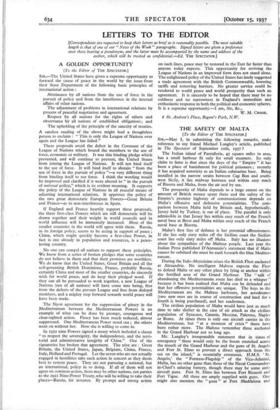THE SAFETY OF MALTA
[To the Editor of THE SPECTATOR.] SIR,—May I, in submitting the following remarks, make reference to my friend Michael Langley's article, published in The Spectator of September loth, 1937?
The Italian island of Pantalleria, 45 square miles in area, has a small harbour fit only for small steamers. Its only claim to fame is that since the days of the " Empire " it has been a place of banishment for political prisoners ; recently it has acquired notoriety as an Italian submarine base. Being installed in the narrow straits between Cap Bon and south- west Sicily, it lies midway between and within easy reach of Bizerta and Malta, from the air and by sea.
The prosperity of Malta depends to a large extent on the amount of British money spent there and the safety of the Empire's premier highway of communications depends on Malta's offensive and defensive potentialities. The com- parison between Malta held by Britain and, hypothetically, Jersey held by Turkey, is out of place. The parallel is only admissible in that Jersey lies within easy reach of the French naval base at Brest and Malta within easy reach of the French naval base at Bizerta.
Malta's first line of defence is her potential offensiveness. If she lies only sixty miles off the Sicilian coast the Sicilian coast lies only sixty miles off Malta. Italy has no illusions about the sympathies of the Maltese people. Last year the Italian Press published D'Annunzio's statement that if Malta cannot be subdued she must be sunk beneath the blue Mediter- ranean.
During the Italo-Abyssinian crises the British Fleet anchored at Alexandria. No intelligent Maltese expects the Fleet to defend Malta or any other place by lying at anchor within the fortified area of the Grand Harbour. The "talk of abandoning the Mediterranean route has died to a whisper" because it has been realised that Malta can be defended and that her offensive potentialities are unique. The keys to the Mediterranean are the Maltese harbours, her aerodromes (two new ones are in course of construction and land for a fourth is being purchased), and her seadromes.
The civilian population of Malta would have just as much time to take shelter in the case of air attack as the civilian population of Syracuse, Catania, Messina, Palermo, Naples or Rome. At times there is only one aircraft carrier in the Mediterranean, but "at a moment of crisis" there have been rather more. The Maltese remember three anchored in the Grand Harbour not so long ago.
Mr. Langley's irresponsible statement that in times of emergency "there would only be the boom stretched across the mouth of the Grand Harbour and the guns of St. Angelo and Fort St. Elmo to prevent a direct approach from the sea on the island," is essentially erroneous. H.M.S. 'St. Angelo,' the " Fortress-Flagship " of the Vice-Admiral, Malta, has no other guns than those of the Naval Commander- in-Chief's saluting battery, though there may be some anti- aircraft guns. Fort St. Elmo lies between Fort Ricasoli and Fort Tigne. All three are amply supplied with guns. One might also mention the " guns " at Fort Maddalena and Benghisa and St. Leonard, and the innumerable moveable guns manned by the Royal Artillery.
Malta's future safety lies in the command of the seas, and also very considerably in its air force which is capable of unlimited expansion. Four aerodromes (the iViarsa polo ground makes a fifth in an emergency) and two seadromes at Marsaxlokk and St. Paul's (the Grand Harbour may be considered as a third) can cope with any emergency and should make any potential aggressor think twice before ven- turing to rouse us to action.—Yours faithfully,
I8A Scottish Street, Valletta.
J. OLIVIERI-MUNROE.























































 Previous page
Previous page